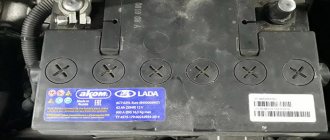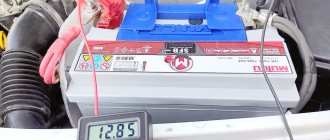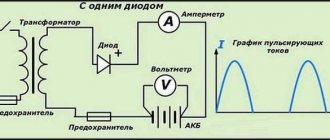The car battery voltage is the leading indicator on the basis of which a competent driver should draw conclusions about the condition of the battery, whether it needs charging or replacement. It is known that there is a direct dependence of voltage on the charge level of a car battery. First, we will consider the question of what voltage indicators can be used to draw a conclusion about the performance of the battery, why the battery loses U and what the voltage standard means. After this, we will try to determine the battery charge by voltage: a table on the basis of which certain conclusions about the state of the battery are drawn will be attached at the end of the article.
The battery loses voltage: what is the reason?
If a charged power source quickly discharges, there may be several reasons for this “behavior” of the battery. The battery charge level can quickly drop due to a natural reason: the battery has simply exhausted its resource in the usual way and needs to be replaced.
The generator, which charges the battery while driving, may also fail, helping it maintain the required level of operating condition. If the battery is not yet old and the alternator is in order, the car probably has serious problems with current in the form of constant leakage.
In addition, the car's on-board network may be faulty - for example, the radio or some other device takes too much current, and the battery simply cannot cope with this load.
In order to eliminate the voltage drop, sometimes it is enough to correct the problem by performing a technical inspection, identifying the cause, eliminating it, and re-measuring the voltage at the battery terminals after several hours of operation. It is also important to evaluate such indicators as the level of electrolyte density, as well as measure the voltage under and without load. Read more about checking the battery with a load fork →
How many amps should a charged battery show?
To determine the battery charge, you need to know how many volts a charged battery should show. The voltage will directly indicate the battery’s ability to power consumers. When fully charged, the terminals should read 12.6V or higher. A voltage of 12.5 V indicates a charge of 85-90%. A typical working battery rating is 12.2-12.4 V, since the battery in a car is almost never fully charged unless it has just been taken off the charger by a stationary charger.
How many amperes should a charged battery show, focusing on the issue of reserve capacity? Typically, in such tests for reserve capacity, the value chosen is 25 A, since this is approximately equal to the current that the car consumes to operate a gasoline engine (third-party consumers are not taken into account). A battery with a reserve capacity of at least 110 minutes is considered good for a typical middle-class passenger car. This means that the car can drive for almost two hours on a fully charged battery, even if its on-board generator fails.
What does normal battery voltage mean?
For normal battery operation, its voltage should fluctuate between 12.6-12.7 volts, no less. This norm should be learned by novice drivers, like a multiplication table - in order not to miss the critical level of battery charge drop and not to find yourself in a position where the car suddenly “stops”.
You should also know that, depending on the characteristics of the battery and vehicle, as well as other related conditions, the norm may vary - up to 13 volts and slightly higher. This is exactly what some battery manufacturers say, and this factor also needs to be taken into account. How many volts should ideally be is a relative figure. But you should always focus on readings from 12.6 to 13.3 volts - depending on the type and country of origin of the battery.
If the voltage in the battery drops below 12 volts, it is at least half discharged, and when it drops below 11.6 volts, the battery urgently needs charging.
So, the normal voltage indicator for most car batteries is from 12.6 to 12.7 volts, and if a non-standard battery model is used, the U standard may be slightly higher: 13 volts, but a maximum of 13.3. Some novice motorists ask what the ideal U-value should be. Of course, there are no ideal numbers, since the current level in the car’s network, weather conditions, and energy consumption by individual elements of the car’s on-board network can change.
In order not to miss the moment when the battery charge begins to drop to a critical level, there is a so-called battery charge table. If you measured U at the terminals of your battery, you can determine the battery charge by voltage: the table will help you navigate this. It shows a directly proportional dependence of U on the charge level of the battery as a percentage.
The table also shows the density of the electrolyte and the temperature at which it can freeze in the cold season - also depending on the charge level and U in the battery.
How to correctly measure the voltage on the battery and in the vehicle’s on-board network
Let us repeat that the battery voltage is an indicator of its operating condition. There are several ways to measure it:
- using a multimeter or voltmeter;
- using a load fork;
- measuring the density of the electrolyte.
Next, we will consider each of the listed options in more detail.
Multimeter or voltmeter
To measure the voltage on the battery, many use a simple and very long-used, and therefore proven, method - using a multimeter. This device allows you to make measurements with an accuracy of tenths and even hundredths of a volt.
Important! To obtain reliable results, it is necessary that 4-5 hours have passed since the last charge or discharge. During this time, the voltage stabilizes.
To measure, switch the multimeter to constant voltage measurement mode and the measurement limit closest to 12 V, usually 20 volts, designated “20 DCV”.
If there is a need to more accurately measure the battery charge level, you will have to use special chargers that have memory and a microprocessor. With their help, it is possible to track and compare not only the discharge process, but also the normal charging of the battery over a certain number of cycles.
Checking and measuring with a load fork
The essence of this method of checking the normal battery voltage is extremely simple - measurements are made under load, which allows you to accurately assess the condition of the battery.
To make it clear, let's look at an example. If a battery with a capacity of 60 Ah is checked, then the minimum load should be 120 A. It is applied for 3-5 seconds. More information on using the load fork can be found here: .
Electrolyte density measurement
For vehicles that have serviceable batteries with liquid electrolyte, the state of charge can be determined by measuring its density. The relationship between these parameters is clearly shown in the table below.
| Charge level (%) | Electrolyte density (g/cm3) |
| 100 | 1.266 |
| 95 | 1.258 |
| 90 | 1.250 |
| 85 | 1.242 |
| 80 | 1.234 |
| 78 | 1.226 |
| 70 | 1.219 |
| 65 | 1.212 |
| 60 | 1.205 |
| 55 | 1.198 |
| 50 | 1.191 |
| 40 | 1.177 |
| 30 | 1.163 |
| 20 | 1.149 |
| 10 | 1.135 |
To be fair, it should be noted that the information contained in the table is valid for batteries used in the middle zone. Depending on climatic conditions, the normal density varies:
- 1.27-1.29 g/cm3 - for cold regions, and at any time of the year;
- 1.25-1.27 g/cm3 - as we have already said, for the middle band;
- 1.23-1.25 g/cm3 - places with high average annual air temperatures.
For your information! Density checks are carried out once every 3 months. Even minor deviations from the norm are unacceptable.
Battery charge level table
| Electrolyte density, g/cm³ | Voltage without load | Voltage under load 100 amperes | Battery charge level, % | Electrolyte freezing point, °C |
| 1,11 | 11,7 | 8,4 | 0 | -7 |
| 1,12 | 11,76 | 8,54 | 6 | -8 |
| 1,13 | 11,82 | 8,68 | 12,56 | -9 |
| 1,14 | 11,88 | 8,84 | 19 | -11 |
| 1,15 | 11,94 | 9 | 25 | -13 |
| 1,16 | 12 | 9,14 | 31 | -14 |
| 1,17 | 12,06 | 9,3 | 37,5 | -16 |
| 1,18 | 12,12 | 9,46 | 44 | -18 |
| 1,19 | 12,18 | 9,6 | 50 | -24 |
| 1,2 | 12,24 | 9,74 | 56 | -27 |
| 1,21 | 12,3 | 9,9 | 62,5 | -32 |
| 1,22 | 12,36 | 10,06 | 69 | -37 |
| 1,23 | 12,42 | 10,2 | 75 | -42 |
| 1,24 | 12,48 | 10,34 | 81 | -46 |
| 1,25 | 12,54 | 10,5 | 87,5 | -50 |
| 1,26 | 12,6 | 10,66 | 94 | -55 |
| 1,27 | 12,66 | 10,8 | 100 | -60 |
How long should a car battery be charged?
Initially, using the regulator, a current equal to 1/10 of its capacity is set. After a few hours, this value will begin to decrease automatically to prevent the electrolyte from boiling. When the car battery is fully charged, only 200 mA (self-discharge current value) will be supplied to its terminals. The battery with the “charger” connected can remain in this state for as long as desired without any damage to itself.
Modern automatic “chargers” can be used as starting devices to make it easier to start the engine. To do this, you need to connect it to the battery, set the maximum amperage, wait 10-15 minutes, and then, without turning it off, start the car engine. After the engine has started, the driver needs to drive at least 10 km so that the generator can at least slightly recharge the battery for the subsequent successful start of the engine.
More to read: Construction work on weekends in Moscow
How long does it take to charge a car battery?
This method of charging the battery is used in cases where you need to quickly restore capacity for at least one engine start. For this purpose, many modern chargers have a Boost mode. When this mode is turned on, an increased current value is given when charging. In this case, the charging time of the car battery required to start the engine is about 20 minutes.
- first stage. The current is set to 0.1 of the nominal battery capacity. For 60 Ah batteries common in passenger cars, the value should be set to 6 amperes. This current must be maintained to 14.4 volts. Use a multimeter to control;
- second stage. The value of 14.4 volts was not chosen by chance. When this voltage is reached, the electrolysis of water increases sharply, as a result of which water breaks down into oxygen and hydrogen. Therefore, in the second stage, the charge current is reduced by half. In our case, up to 3 amperes;
- third stage. When the voltage on the battery increases to 15 volts, the current must be reduced by another 2 times (1.5 amperes). At this stage, check the voltage every 1-2 hours. If it remains constant and active gas evolution is observed in the banks, then the charging process can be stopped.
Under load
To find out the battery voltage, you need to purchase a special device. However, it only allows you to find out the readiness of the battery for further operation and the state of charge of the battery. This product is not suitable for determining energy content. For this reason, there is no way to determine the battery life through this product.
The device has the following equipment, which includes:
- housing with a built-in device, a multimeter;
- spirals that provide resistance;
- cables that have “crocodiles” at the ends for easy connection to the battery;
- switch.
There are 2 types of such products: digital, which show the parameter on the display, and analog, which shows the value using an arrow. The first type is better because it produces a more accurate value compared to the second. Most load forks operate at positive temperatures from 1˚С to 35˚С. But there are products that can work well even at -25˚С, but the cost of such a device will be many times higher than conventional devices. The product can generate current from 100A to 200A.
A battery test using a load fork can be performed within 10 seconds, although according to harmonized standards the test can be performed for 20 seconds.
How to check the operation of the generator
The battery in a car is an important element of the system, which is responsible for providing the car’s on-board network with electricity. The generator is used to charge the battery while it is active. Unstable operation of a device generating electricity causes a voltage drop in the network and failure to restore the capacity of the power source.
Normal generator performance means timely and complete replenishment of the battery charge level, which decreases under load. Checking the battery charge level from the generator is simple and can be done by the car owner himself.
Diagnostics of an automotive energy-generating device includes a visual inspection of the unit, its elements and related parts, as well as voltage and current measurements. At least twice a year, you should check the tension of the drive belt, excessive weakening of which leads to a decrease in the performance of the generator, and sometimes can lead to breakdown of the device. Once a year, you can check equipment elements - fasteners, diode bridge, voltage regulator and others. Timely maintenance of the battery will also guarantee the absence of problems - cleaning the terminals, adding distilled water.
Diagnostics of indicators such as voltage, current, resistance are also necessary twice a year. To carry it out, you will need special devices - a voltmeter, multimeter or load fork.











